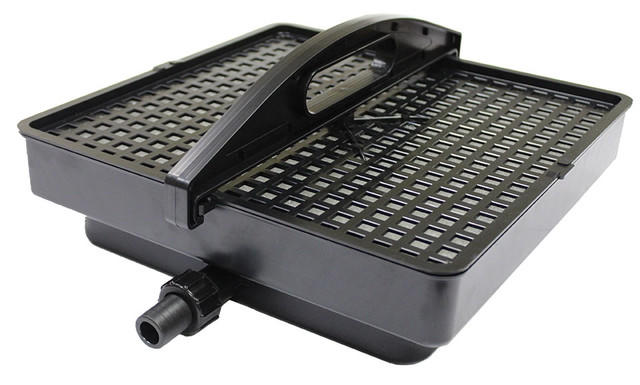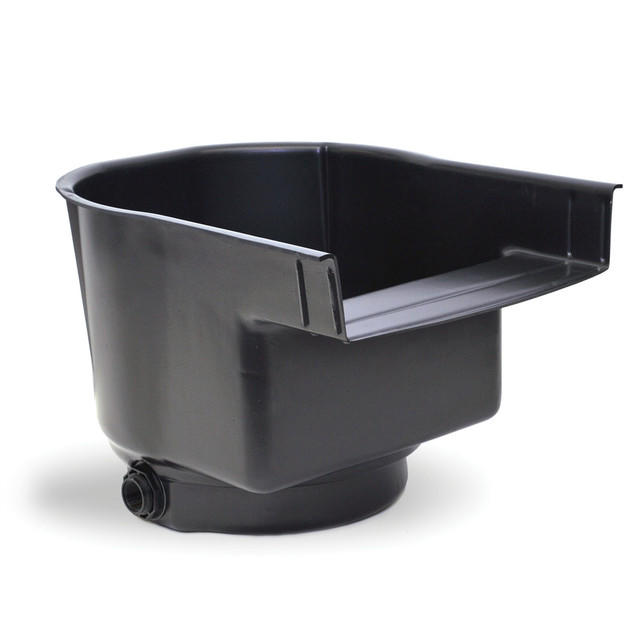Types of Filters
There are many types of filters in use in ponds and water gardens. And countless models of each on the market. This guide should serve as an introduction to help aid in selecting the best filter system for your pond.
In-Pond Filter

What is an in-pond filter?
As the name suggests, these filters are completely submerged in the pond. In-pond filters can be as simple as a screen attached to the pump. Or it may be a filter that the pump sits inside of such as the Matala Pump Defender or homemade bucket filters. There are also many great “all-in-one” filters available like the Oase Filtral filters. All-in-one filters include the pump, filter, and usually an ultraviolet clarifier as well as fountain head attachments.
When would I want to use an in-pond filter?
An in-pond filter may work for you if you have a small pond or a pond with very few fish. It can work if you don’t mind reaching into the pond bottom to access the pump for cleaning. In-pond filters also tend to be the least costly filter options available. These filters can also be added when just a little more filtration is needed in an existing pond. In-pond filters can also just be the pre-filter or a more advanced filter system.
What drawbacks might I need to consider?
The in-pond filter may require frequent service and is placed in a harder to reach area in the pond bottom. Some of the in-pond filters can be heavier and hard to pull out of the pond for cleaning.
Skimmer
What is a pond skimmer?
A pond skimmer is a unit that is usually buried just outside of the pond, the opening penetrates the liner to connect to the pond. The skimmer will have a basket, debris net, filter mat, bushes or a combination of those and then the submersible pump will be inside the skimmer. The skimmer is installed so that it pulls water from the top layer of the pond and with it most surface debris including pollen, leaves, etc. Since a skimmer will primarily only provide mechanical filtration, you usually use this only as a pre-filter in addition to a biological filter.
When would I want to use a pond skimmer?
A skimmer allows you to clean the pre-filtration and service the pump without reaching down into the pond bottom. You barely have to get your hands wet. A skimmer can also be of great advantage in areas where debris may be getting into the pond and needs to be skimmed off so it doesn’t settle in the bottom of the pond. Since a skimmer is the mechanical pre-filter it can be used on virtually any pond size, but is not commonly used on small ponds under about 400 gallons.
What drawbacks might I need to consider?
In many ponds, especially deeper ponds, if you only pull water from the surface it can lead to poor circulation and a stagnant pond bottom. A great option is to use a 2 pump system with one pump in the skimmer and one pulling from deeper in the pond. Installation of a skimmer does involve cutting a hole in the pond liner which can make some people nervous. Skimmers need regular maintenance to prevent the pump from running dry.
Waterfall Filter
What is a waterfall filter?
Waterfall filters are thus named since they are placed at the top of the waterfall or stream in a pond. The water is pushed from the pond into the bottom of the waterfall filter, the water then flows through filter media before exiting the filter over a waterfall weir which begins the decorative part of the waterfall flow. The filter media within the filter can vary, this can be filter mats, bio-balls, bio-ribbon, and more.
When would I want to use a waterfall filter?
A waterfall filter is a very common filter for natural looking ponds as they can be fairly easily incorporated into the design. You want a way to disperse the water to provide a waterfall flow and a waterfall filter allows you to do that and provide both mechanical and biological filtration. Waterfall filters can be the primary filter on small to medium watergardens but will not generally be adequate on their own for a koi pond.
What drawbacks might I need to consider?
The filter media in a waterfall filter usually needs manual cleaning, so it can be a dirty job.
Pressure Filter
What is a pressure filter?
A pressure filter is a fully enclosed pond filter that allows it to be placed at almost any location outside of the pond. The water is pushed into the filter and the water flow remains under pressure as it is carried via piping back to the pond. Pressure filters may contain filter foam but also contain plastic media like bio-balls. Pressure filters usually are cleaned by backwashing meaning you don’t even have to get your hands wet.
When would I want to use a pressure filter?
Pressure filters have the advantage of easy cleaning through backwashing. These filters often have an ultraviolet light built in for improved water clarity. The ability to place in-line on the piping makes it versatile to hide in the landscape. It also makes it easy to add this as additional filtration in an existing system.
What drawbacks might I need to consider?
Pressure filters have a limited flow rate that they can handle, when choosing a pressure filter it is important to follow the manufacturer’s guidelines. There are many pressure filters on the market, a lot of these simply do not hold up well and leaking can occur (following flow recommendations helps prevent this, but sometimes it is just a lesser quality model).
Bead Filter
What is a bead filter?
We’re using this term a little loosely here. Bead filters are technically also pressurized filters, fully enclosed and installed in-line on the piping. However, this type has an appearance similar to swimming pool sand filters. Originally these filters used plastic beads as an alternative to sand as sand isn’t suitable for pond filtration. Advances in technology have led most of these filters to use plastic media that provides more surface area than a basic bead. Like the other pressure filters these are cleaned with backwash so you can keep yourself clean and dry when cleaning the pond filter.
Why would I want to use a bead filter?
Pressurized bead filters provide a high level of both mechanical and biological filtration. These filters are well suited to larger ponds especially koi ponds or heavily stocked ponds. Bead filters are easy to clean with a simple backwash.
What drawbacks might I need to consider?
Bead filters are often more expensive than other options. Sizing a matching pump may also take more precision. Often the plumbing may be more complicated.
Gravity Discharge Filter
What is a gravity discharge filter?
This type of filter is placed above the pond water level, it may feed into a stream or straight back into the pond. The pond water is pumped into the filter housing where it passes through the filter media and flows out of the filter by gravity, thus the placement above water level. The water may pass up through the media, down through the media, or horizontally across the media. Cleaning depends on the specific filter. Most are manual cleaning. Some, such as the Oase BioSmart filters, have a drain and have tools to allow you to compress the media to clean.
Why would I want to use a gravity discharge filter?
Gravity discharge filters are usually a cost effective way to get good mechanical and biological filtration. There are also some units like the Oase Screenmatic that automate part of the cleaning process (these of course will add to the cost).
What drawbacks might I need to consider?
These filters are often harder to hide in the landscape. Since you are pumping water in with force and it leaves by gravity, ensuring the pump is not oversized is critical.
Gravity Fed Filter
What is a gravity fed filter?
Gravity fed filters are installed at pond level (the top of the water in the filter will be the same as the top of the pond). The pump is drawing water through the filter rather than being pumped into the filter. This class of filters feature the Nexus which is a premium koi pond filter.
Why would I want to use a gravity fed filter?
This type of filter also gets the pump and filter out of the pond bottom making maintenance often easier and cleaner. The Nexus filter is great for dedicated koi ponds and has the options for automated cleaning.
What drawbacks might I need to consider?
Since these filters are installed at pond level, it is critical to ensure they are installed on a firm base at the right level. These filters usually need to operate with a bottom drain in the pond as well as an external pump. Plumbing for these filters is often more complicated.
Drum Filter
What is a drum filter? 
Drum filters feature a rotating drum that uses a fine mesh screen for excellent mechanical filtration. These filters may be in either a gravity fed or gravity discharge filter position. The debris is usually automatically removed from the screen.
When would I want to use a drum filter?
If you have a koi pond and are looking for a complete system for superior filtration the removal of fine debris can be a key component to immaculate water.
What drawbacks might I need to consider?
Drum filters can be expensive and like other filters for the serious koi keeper the plumbing may be more complicated.


